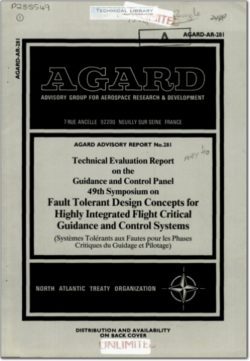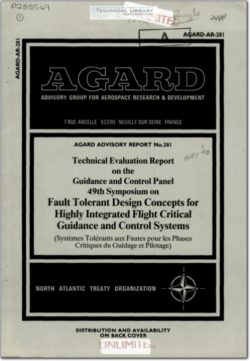AGARD-AR-281

- Version
- 280 Downloads
- 3.80 MB File Size
- 1 File Count
- March 8, 2016 Create Date
- March 8, 2016 Last Updated
Fault Tolerant Design Concepts for Highly Integrated Flight Critical Guidance and Control Systems

The trend towards highly integrated systems continues to expand at a rapid rate. Recent examples include automated
maneuvering attack systems, flight control/fire control coupling, mission sensor management, real-time armament fuzing and
propulsion coupling/performance optimization.
The prospect of improved mission effectiveness through integrated systems is a very real and powerful motivation with far
reaching implications. Recent advances in microprocessor technology are bringing about fundamental changes in several
traditional functional domains. Specifically, systems architecture requirements, partitioning considerations and functional
performance parameters take on new meaning in the context of fully integrated flight critical systems. Effective system
integration focuses on end—item functional performance using the most efficient mechanization possible. In this regard, system
wide consideration of sensing elements, computational elements and command signalling loops are critically important. Crew
station design considerations and the pilot‘s role must also be thoroughly assessed vis-a-vis varying levels of task automation
and overall system wide integrity management requirements.
Achieving the full potential of integrated systems is highly dependent upon demonstrating adequate reliability, safety and
survivability. Historical evidence indicates that interfacing subsystems can introduce serious compromises in overall system
safety and performance. High integrity software is essential. Satisfying stringent flight critical system requirements necessitates
innovative fault tolerant design approaches and mechanization schemes. Adding redundancy levels across the full spectrum of
system elements is a self-limiting approach based on practical considerations of weight, volume, cost and supportability.
Reconfiguration strategies, graceful degradation and aerodynamic redundancy are but a few of the modern concepts currently
under development. State estimation techniques in conjunction with artificial intelligence technology also offer potential fault
tolerance enhancements. Blending system elements for fully integrated or multi-purpose usage under both nominal and
extreme operating conditions, requires an intensive system integration effort to achieve acceptable levels of fault tolerance.
| File | Action |
|---|---|
| AGARD-AR-281 Fault Tolerant Design Concepts for Highly Integrated Flight Critical Guidance and Control Systems.pdf | Download |

Comment On This Post